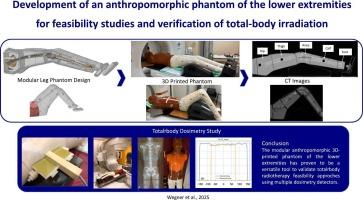拟人下肢幻肢的开发,用于全身照射的可行性研究和验证
IF 2.7
3区 医学
Q1 RADIOLOGY, NUCLEAR MEDICINE & MEDICAL IMAGING
Physica Medica-European Journal of Medical Physics
Pub Date : 2025-07-16
DOI:10.1016/j.ejmp.2025.105045
引用次数: 0
摘要
背景:全身照射(TBI)是一种特殊的放疗治疗,与化疗一起使用,为白血病患者干细胞移植做准备。对于适形照射技术的调试和验证,全身解剖细节的幻影起着重要的作用。本研究旨在创造一种具有成本效益的模块化下肢假体,可以与商业躯干假体结合使用,从而优化TBI治疗计划和剂量递送。方法设计由足、小腿、膝盖、大腿和臀部五个关键部位组成的模块化腿模。膝盖和臀部的变化允许伸直和倾斜的腿的位置。剂量计的插入物被集成到膝关节和髋关节,以及股骨和腓骨内。为了评估创伤性脑损伤的幻体功能,我们分析了目前使用的静场技术,并研究了强度调制扫描波束技术的可行性。结果我们使用3D打印技术制作了骨骼、骨盆和腿部的空心结构,并填充了代表软组织和骨髓的替代材料。我们用石膏涂层模拟皮质骨。软组织和骨替代物的CT数字与文献数据一致。即使在制造一年后,材料性能仍保持稳定,确保了幻影的长期使用。静场技术的第一次剂量验证测量结果显示与规定剂量在±10%以内一致。结论该模块化模体可与商业躯干模体相结合,可用于各种基于ct的TBI技术的优化和验证。本文章由计算机程序翻译,如有差异,请以英文原文为准。

Development of an anthropomorphic phantom of the lower extremities for feasibility studies and verification of total-body irradiation
Background
Total-body irradiation (TBI) is a specialised radiotherapy treatment used alongside chemotherapy to prepare leukaemia patients for stem cell transplants. For commissioning and validation of conformal irradiation techniques, anatomically detailed phantoms of the whole body play an important role. This study aimed to create a cost-effective modular phantom of the lower extremities that can be combined with a commercial torso phantom, thus enabling the optimisation of TBI treatment planning and dose delivery.
Methods
We designed a modular leg phantom consisting of five key components: foot, calf, knee, thigh, and hip. Variants of knee and hip allow for both straight and angled leg positions. Inserts for dosimeters are integrated into the knee and hip joints, as well as within femur and fibula. To assess the phantom functionality in TBI, we analysed a currently used static-field technique and studied the feasibility of an intensity-modulated sweeping-beam technique.
Results
We employed 3D printing to create hollow structures of bones, pelvis, and legs, which we filled with surrogate materials representing soft tissue and bone marrow. We simulated cortical bone with a gypsum coating. The CT numbers of soft tissue and bone surrogates align accurately with literature data. The material properties remained stable even one-year post-manufacturing, ensuring long-term use of the phantom. First dose verification measurements for the static-field technique show an agreement with the prescribed dose within less than ±10 %.
Conclusion
The cost-effective modular phantom can be combined with a commercial torso phantom, allowing for the optimization and verification of various CT-based TBI techniques.
求助全文
通过发布文献求助,成功后即可免费获取论文全文。
去求助
来源期刊
CiteScore
6.80
自引率
14.70%
发文量
493
审稿时长
78 days
期刊介绍:
Physica Medica, European Journal of Medical Physics, publishing with Elsevier from 2007, provides an international forum for research and reviews on the following main topics:
Medical Imaging
Radiation Therapy
Radiation Protection
Measuring Systems and Signal Processing
Education and training in Medical Physics
Professional issues in Medical Physics.

 求助内容:
求助内容: 应助结果提醒方式:
应助结果提醒方式:


